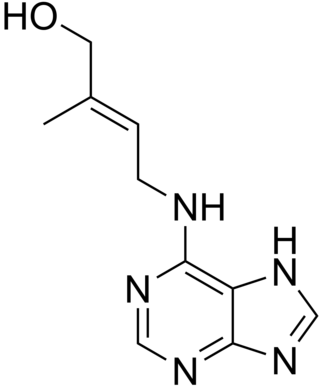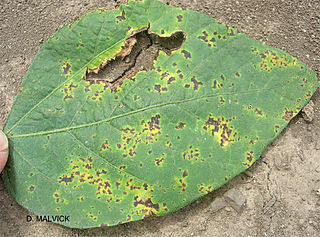Related Research Articles

Arabidopsis thaliana, the thale cress, mouse-ear cress or arabidopsis, is a small plant from the mustard family (Brassicaceae), native to Eurasia and Africa. Commonly found along the shoulders of roads and in disturbed land, it is generally considered a weed.

A protease is an enzyme that catalyzes proteolysis, breaking down proteins into smaller polypeptides or single amino acids, and spurring the formation of new protein products. They do this by cleaving the peptide bonds within proteins by hydrolysis, a reaction where water breaks bonds. Proteases are involved in numerous biological pathways, including digestion of ingested proteins, protein catabolism, and cell signaling.

Cytokinins (CK) are a class of plant hormones that promote cell division, or cytokinesis, in plant roots and shoots. They are involved primarily in cell growth and differentiation, but also affect apical dominance, axillary bud growth, and leaf senescence.

Hypersensitive response (HR) is a mechanism used by plants to prevent the spread of infection by microbial pathogens. HR is characterized by the rapid death of cells in the local region surrounding an infection and it serves to restrict the growth and spread of pathogens to other parts of the plant. It is analogous to the innate immune system found in animals, and commonly precedes a slower systemic response, which ultimately leads to systemic acquired resistance (SAR). HR can be observed in the vast majority of plant species and is induced by a wide range of plant pathogens such as oomycetes, viruses, fungi and even insects.
The gene-for-gene relationship is a concept in plant pathology that plants and their diseases each have single genes that interact with each other during an infection. It was proposed by Harold Henry Flor who was working with rust (Melampsora lini) of flax (Linum usitatissimum). Flor showed that the inheritance of both resistance in the host and parasite ability to cause disease is controlled by pairs of matching genes. One is a plant gene called the resistance (R) gene. The other is a parasite gene called the avirulence (Avr) gene. Plants producing a specific R gene product are resistant towards a pathogen that produces the corresponding Avr gene product. Gene-for-gene relationships are a widespread and very important aspect of plant disease resistance. Another example can be seen with Lactuca serriola versus Bremia lactucae.

Pseudomonas syringae is a rod-shaped, Gram-negative bacterium with polar flagella. As a plant pathogen, it can infect a wide range of species, and exists as over 50 different pathovars, all of which are available to researchers from international culture collections such as the NCPPB, ICMP, and others.
Turnip crinkle virus (TCV) is a plant pathogenic virus of the family Tombusviridae. It was first isolated from turnip.

Serine/threonine-protein kinase PAK 2 is an enzyme that in humans is encoded by the PAK2 gene.

WNK , also known as WNK1, is an enzyme that is encoded by the WNK1 gene. WNK1 is serine-threonine protein kinase and part of the "with no lysine/K" kinase WNK family. The predominant role of WNK1 is the regulation of cation-Cl− cotransporters (CCCs) such as the sodium chloride cotransporter (NCC), basolateral Na-K-Cl symporter (NKCC1), and potassium chloride cotransporter (KCC1) located within the kidney. CCCs mediate ion homeostasis and modulate blood pressure by transporting ions in and out of the cell. WNK1 mutations as a result have been implicated in blood pressure disorders/diseases; a prime example being familial hyperkalemic hypertension (FHHt).
Resistance genes (R-Genes) are genes in plant genomes that convey plant disease resistance against pathogens by producing R proteins. The main class of R-genes consist of a nucleotide binding domain (NB) and a leucine rich repeat (LRR) domain(s) and are often referred to as (NB-LRR) R-genes or NLRs. Generally, the NB domain binds either ATP/ADP or GTP/GDP. The LRR domain is often involved in protein-protein interactions as well as ligand binding. NB-LRR R-genes can be further subdivided into toll interleukin 1 receptor (TIR-NB-LRR) and coiled-coil (CC-NB-LRR).
IgA protease is an enzyme. This enzyme catalyses the following chemical reaction[reaction equation needed]
Pestivirus NS3 polyprotein peptidase is an enzyme. This enzyme catalyses the following chemical reaction
Jane Glazebrook is an American botanist known for her work on understanding plant defenses against pathogens and increasing crop yields. She received her Ph.D. from the Massachusetts Institute of Technology in 1991 and is now a professor of Plant Biology at the University of Minnesota. She was the editor-in-chief of the journal Molecular Plant-Microbe Interactions. She is married to Fumiaki Katagiri, who also works at the University of Minnesota as a professor of Plant Biology.
Guard theory is a branch of immunology which concerns the innate sensing of stereotypical consequences of a virulence factor or pathogen. This is in contrast to the classical understanding of recognition by the innate immune system, which involves recognition of distinct microbial structures- pathogen-associated molecular patterns (PAMPs)- with pattern recognition receptors (PRRs). Some of these stereotypical consequences of virulence factors and pathogens may include altered endosomal trafficking and changes in the cytoskeleton. These recognition mechanisms would work to complement classical pattern recognition mechanisms.
WRKY transcription factors are proteins that bind DNA. They are transcription factors that regulate many processes in plants and algae (Viridiplantae), such as the responses to biotic and abiotic stresses, senescence, seed dormancy and seed germination and some developmental processes but also contribute to secondary metabolism.

Bacterial blight of soybean is a widespread disease of soybeans caused by Pseudomonas syringaepv. glycinea.
RPS5 may refer to:
Mitogen-activated protein kinase (MAPK) networks are the pathways and signaling of MAPK, which is a protein kinase that consists of amino acids serine and threonine. MAPK pathways have both a positive and negative regulation in plants. A positive regulation of MAPK networks is to help in assisting with stresses from the environment. A negative regulation of MAPK networks is pertaining to a high quantity of reactive oxygen species (ROS) in the plant.

FLS genes have been discovered to be involved in flagellin reception of bacteria. FLS1 was the original gene discovered shown to correspond with a specific ecotype within Arabidopsis thaliana. Even so, further studies have shown a second FLS gene known as FLS2 that is also associated with flagellin reception. FLS2 and FLS1 are different genes with different responsibilities, but are related genetically. FLS2 has a specific focus in plant defense and is involved in promoting the MAP kinase cascade. Mutations in the FLS2 gene can cause bacterial infection by lack of response to flg22. Therefore,FLS2’s primary focus is association with flg22 while its secondary focus is the involvement of promoting the MAP kinase cascade in plant defense.
Brian John Staskawicz ForMemRS is professor of plant and microbial miology at the University of California, Berkeley and scientific director of agricultural genomics at the Innovative Genomics Institute (IGI).
References
- ↑ "PBS1 - Serine/threonine-protein kinase PBS1 - Arabidopsis thaliana (Mouse-ear cress) - PBS1 gene & protein". UniProt . Q9FE20 .
- ↑ "Q9FE20 | SWISS-MODEL Repository". Swiss-model . Q9FE20 .
- ↑ "PDBe-KB Protein Pages". PDBe-KB . Q9FE20 .
- ↑ "Q9FE20 (Q9FE20) - protein - Interpro". EBI . Q9FE20
- 1 2 3 4 5 Kourelis, Jiorgos; van der Hoorn, R.A.L.; Sueldo, Daniela J. (2016). "Decoy Engineering: The Next Step in Resistance Breeding". Trends in Plant Science . Cell Press. 21 (5): 371–373. doi:10.1016/j.tplants.2016.04.001. ISSN 1360-1385. PMID 27083782.
- 1 2 Li, Wei; Deng, Yiwen; Ning, Yuese; He, Zuhua; Wang, Guo-Liang (2020-04-29). "Exploiting Broad-Spectrum Disease Resistance in Crops: From Molecular Dissection to Breeding". Annual Review of Plant Biology . Annual Reviews. 71 (1): 575–603. doi: 10.1146/annurev-arplant-010720-022215 . ISSN 1543-5008. PMID 32197052. S2CID 214600762.
- 1 2 3 4 5 6 7 8 9 10 11 Pottinger, Sarah E.; Innes, Roger W. (2020-08-25). "RPS5-Mediated Disease Resistance: Fundamental Insights and Translational Applications". Annual Review of Phytopathology . Annual Reviews. 58 (1): 139–160. doi: 10.1146/annurev-phyto-010820-012733 . ISSN 0066-4286. PMID 32284014. S2CID 215757180.